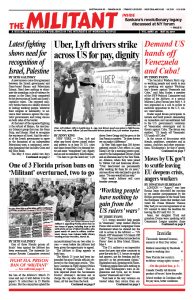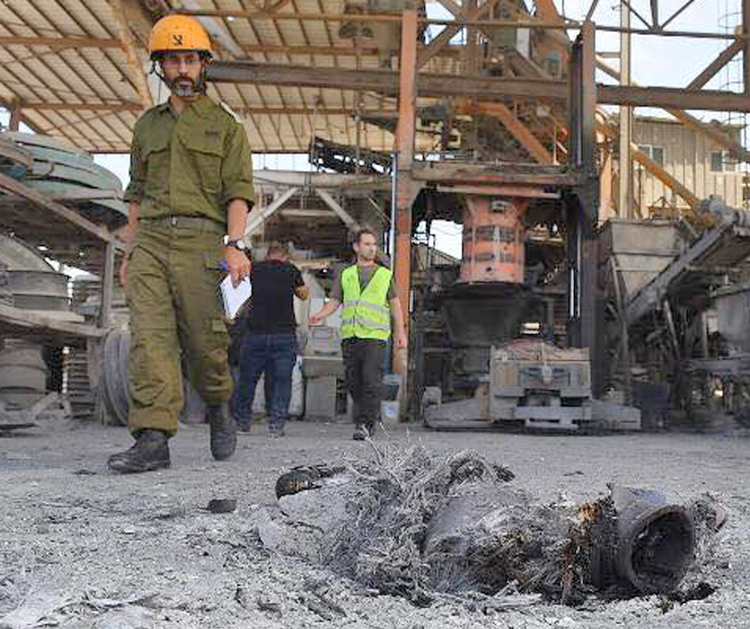A new tenuous cease-fire agreement between the Israeli government and Gaza-based Hamas and Palestinian Islamic Jihad does nothing to eliminate the unending cycle of violence by groups in the Gaza Strip committed to the destruction of Israel and Israel’s capitalist rulers. The repeated military battles there are a deadly obstacle to uniting working people, whatever their religion or nationality, to advance their interests against the capitalist governments and ruling classes on both sides of the border.
At the heart of the repeated fighting is the refusal of Hamas, the reactionary Islamist group that runs the Gaza Strip, and Islamic Jihad to recognize the existence of Israel. And the refusal of the Israeli government to agree to the formation of an independent Palestinian state, a contiguous, sovereign homeland that includes Gaza and the West Bank.
The May 6 truce ended two days of rocket and missile barrages that left four dead in Israel and 25 dead in Gaza, mostly civilians, in the heaviest fighting since 2014. Hamas and Islamic Jihad, both of which receive funds from the counterrevolutionary regime in Tehran, fired 690 rockets from Gaza into Israel, of which just 240 were intercepted by Israel’s anti-missile defense. The Israeli armed forces hit 320 targets in Gaza.
This latest bloodshed comes on top of similar exchanges of fire over the last year, as well as Hamas-led provocative actions on the border with Israel met by deadly fire from Israeli army troops. Numerous cease-fires and agreements saying that Hamas would rein in provocative attacks on Israel and that the Israeli government would ease its economic embargo on the territory have repeatedly come apart.
An endless cycle
During the latest fighting both sides were careful to avoid actions that could escalate into an all-out war, as happened in 2008-09, 2012 and 2014. Several thousand Gaza residents and some 100 Israelis were killed in the course of those wars.
The fighting began May 3 when snipers in Gaza from Islamic Jihad wounded two Israeli soldiers and the Israeli government retaliated.
The Israeli government ruled the Gaza Strip for 38 years, after capturing it, along with the West Bank and the Golan Heights, in the 1967 war. In September 2005, under the impact of the five-year-long uprising by Palestinians in the West Bank and Gaza, Tel Aviv evacuated some 8,000 Israeli settlers and returned Gaza to Palestinian rule. The Israeli government retained control over the territory’s airspace, ports and border crossings.
In March 2006 Hamas won control of the Gaza government and began stepping up armed provocations against Israel. In June 2007 Hamas defeated militias allied with the Fatah-led Palestinian Authority, which rules the West Bank, in bloody street fighting.
As Hamas extended its rule and reactionary course, Israeli authorities closed the border, prohibiting thousands of Gaza residents, who had previously worked in Israel, from entering the country. The Israeli rulers imposed strict restrictions on agricultural products that used to cross freely to be sold in Israel and set limits on fishing.
This had a devastating impact on workers in Gaza. Today 80% of Gaza’s 1.9 million people are dependent on United Nations and other international aid. Unemployment is above 50%.
Hamas leaders defend targeting civilians, homes and factories in Israel. This makes future combat with Israel inevitable and closes down political space there for working people to debate the road forward.
Hamas seeks to use Israel’s retaliation, and the ensuing Palestinian misery, to appeal to capitalist rulers abroad to ostracize Israel.
Meanwhile, Islamic Jihad presents itself as even more aggressive than Hamas in calling for the destruction of Israel.
The working-class road forward
In face of the latest round of fighting, the Socialist Workers Party statement “For Recognition of a Palestinian State and of Israel” is more useful than ever in pointing a way forward. It points to the “political necessity for the Israeli and Arab governments and leaderships of Palestinian organizations to begin immediate talks to recognize both Israel and an independent Palestinian state.”
“Negotiations to reach such an agreement must recognize the right of Jews everywhere to take refuge in Israel in face of the global rise of Jew-hatred and anti-Semitic violence, as well as the unconditional right of the dispossessed Palestinian people to a contiguous, sovereign homeland or territory.”
It points to the history of imperialist domination and capitalist exploitation in the region, including “ruthless colonial and national oppression across the Arab and Muslim countries, as well as the genocidal crimes of the Holocaust, the murderous pogroms preceding it across Eastern and Central Europe and Russia, and the enduring reality of Jew-hatred in today’s crisis-ridden capitalist world.”
The Socialist Workers Party statement explains that the starting point has to be “the class interests and solidarity of workers and toiling farmers across the Middle East — be they Palestinian, Jewish, Arab, Kurdish, Turkish, Persian or otherwise, and whatever their religious or other beliefs — as well as working people in the United States and around the world.”
It concludes, “We are for whatever helps working people organize and act together to advance our demands and struggles against the capitalist governments and ruling classes that exploit and oppress us.”
“We are for whatever renews our class solidarity and self-confidence, advancing us along a revolutionary course toward a united struggle for workers power.”


